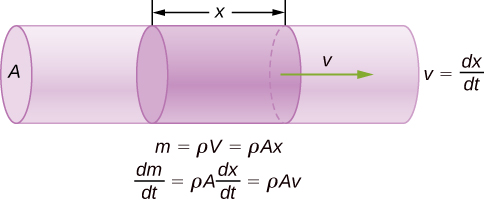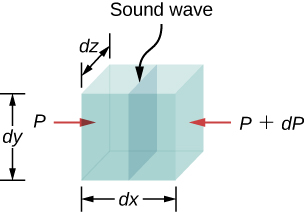| << Chapter < Page | Chapter >> Page > |
The continuity equation from Fluid Mechanics states that the mass flow rate into a volume has to equal the mass flow rate out of the volume,

Now consider a sound wave moving through a parcel of air. A parcel of air is a small volume of air with imaginary boundaries ( [link] ). The density, temperature, and velocity on one side of the volume of the fluid are given as and on the other side are

The continuity equation states that the mass flow rate entering the volume is equal to the mass flow rate leaving the volume, so
This equation can be simplified, noting that the area cancels and considering that the multiplication of two infinitesimals is approximately equal to zero:
The net force on the volume of fluid ( [link] ) equals the sum of the forces on the left face and the right face:

The acceleration is the force divided by the mass and the mass is equal to the density times the volume, We have
From the continuity equation , we obtain
Consider a sound wave moving through air. During the process of compression and expansion of the gas, no heat is added or removed from the system. A process where heat is not added or removed from the system is known as an adiabatic system. Adiabatic processes are covered in detail in The First Law of Thermodynamics , but for now it is sufficient to say that for an adiabatic process, where p is the pressure, V is the volume, and gamma is a constant that depends on the gas. For air, . The density equals the number of moles times the molar mass divided by the volume, so the volume is equal to The number of moles and the molar mass are constant and can be absorbed into the constant Taking the natural logarithm of both sides yields Differentiating with respect to the density, the equation becomes
If the air can be considered an ideal gas, we can use the ideal gas law:
Here M is the molar mass of air:
Since the speed of sound is equal to , the speed is equal to
Note that the velocity is faster at higher temperatures and slower for heavier gases. For air, and If the temperature is the speed of sound is

Notification Switch
Would you like to follow the 'University physics volume 1' conversation and receive update notifications?